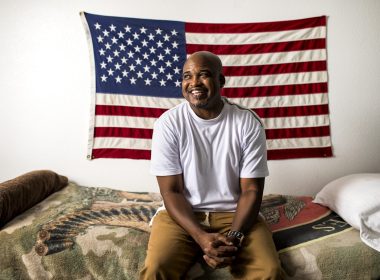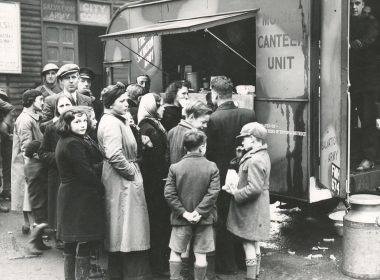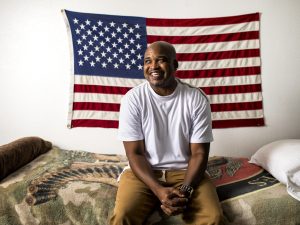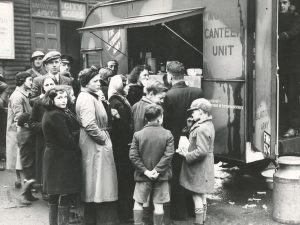While multiple disasters within a short time frame have impacted much of the Army world, the global response reveals a pattern of caring and competence.
by Robert Docter –
Children from Balakot, Pakistan are shown with a new tent provided by The Salvation Army. Tents were distributed as part of recent earthquake relief efforts. Photo courtesy of International Headquarters |
All over the globe Mother Nature has challenged the world’s disaster relief systems in general and The Salvation Army in particular, as giant tidal waves wash away entire communities, floods from torrential rains destroy housing and lives, earthquakes kill, maim and demolish, and hurricanes wipe out dreams and cities. Events over the past year have presented demands for world service that money and physical strength alone cannot satisfy.
The sick, hungry, homeless, destitute, grieving, and depressed of Texas, Louisiana, Alabama, Mississippi, Florida, Mexico, Guatemala, El Salvador, Pakistan, Indonesia, Thailand, Sri Lanka, India, and Romania present themselves physically and emotionally exhausted to countless Salvation Army units for sustenance and support.
In each of nature’s major challenges throughout the world, the Army immediately becomes a major player. The Army’s response occurs primarily because of its historic, worldwide commitment to people in need. Moreover, this Army lives and works nearby. It is already present when disaster strikes. Thousands of officers, soldiers, employees and volunteers move quickly to meet the human needs of victims.
Motivation
On the site of every major natural disaster in this country and throughout the world for more than a century, this Army’s officers and soldiers have demonstrated time after time that The Salvation Army seeks to fill in the gaps in people’s lives—to fill in the blank spaces—to bind the wounds—to care for the widows—to minister to those who grieve. Some of these gaps are physical, some emotional, some social, some economic—and some spiritual. It’s done because of the Army’s belief that social and spiritual redemption go together. The Army’s founder, William Booth, stated the premise in very simple terms: “No one gets a blessing if they have cold feet, and nobody ever got saved while they had a toothache.”
In many different ways, sometimes almost frustratingly unassuming, the Army goes about doing what needs to be done to stem the tide, to buffer a raging wind, to throw out a lifeline, to provide a shelter from the storm—and to get that person back on his or her feet.
Usually first on the scene and the last to leave, the decentralized infrastructure of the Army has the ability to mobilize quickly in order to satisfy its primary motive for action: helping hurting humanity. Its physical assets across the world allow that service to become long range.
Coordination
As international inspection teams assess the scope of the challenge and begin coordination with both governmental entities and other agencies, the local Army units quickly began to provide emergency service with food, water, temporary housing, and emotional support.
In testimony before the Senate Subcommittee on Finance, Major George Hood, USA national community relations and development secretary, explained why this inter agency coordination is so essential: “I do not know of any single charitable organization that, on its own, is capable of providing the full range of disaster response services that is usually required to put communities back on their feet as the result of a natural disaster. Charitable organizations, therefore, routinely coordinate activities with one another as well as with official government emergency management agencies.”
Army expertise
The Salvation Army is listed among the eight major disaster relief organizations in the nation. Over a century-long history of non-discriminatory response it has developed particular areas of expertise. Similarly, each of the other seven responders is noted for having a specific set of skills and assets to bring to bear on a particular disaster. Concerning the Army, Hood testified: “We have developed the following areas of expertise in disaster response—immediate massed feeding of survivors and emergency responders; sheltering those affected while tending to their spiritual and emotional needs in the immediate aftermath of the disaster; continuation of social service—365 days a year—by providing long-term assistance to ensure that the survivors have the means necessary to move back into some semblance of routine they knew before the disaster struck.” Hood noted that client problems magnify following a disaster, and that this element of problem magnification requires on-going support well beyond the impact of a storm or fire or earthquake or terrorist attack.
Hundreds of corporations, thousands of businesses, and millions of individuals donated money, goods, and prayers for those hurt and grieving and for those who ministered to them. Over the past ten months, giving to the Army for disaster relief has exceeded any prior period. Contributions supporting the Army’s work in the three Gulf region hurricanes exceeded $270 million dollars alone, according to Hood. All of these funds go in support of the survivors of the specific disaster for which they have been donated.
Army fund raisers admit that the challenge comes in helping many of these donors become sensitive to the needs of individuals in distant lands who are unable to generate resources sufficient to meet those needs. Moreover, while funding support increases at the time of the disaster, donors also need to become aware of the long range manner and expense related to dealing with the millions of daily personal disasters confronting survivors worldwide.











